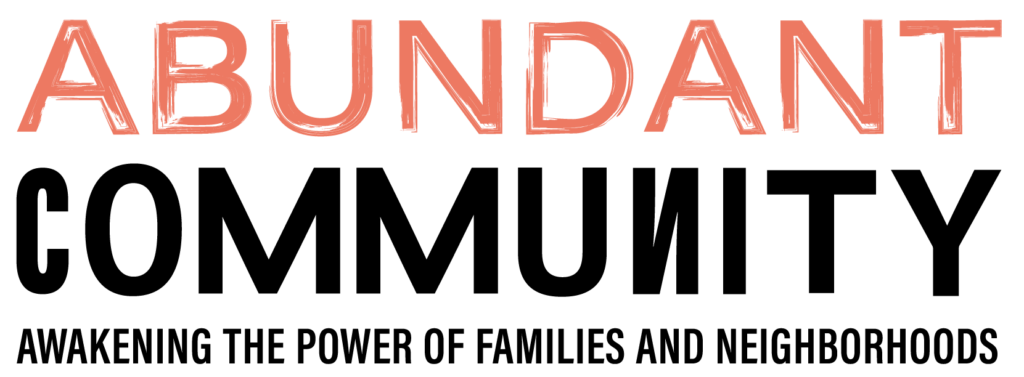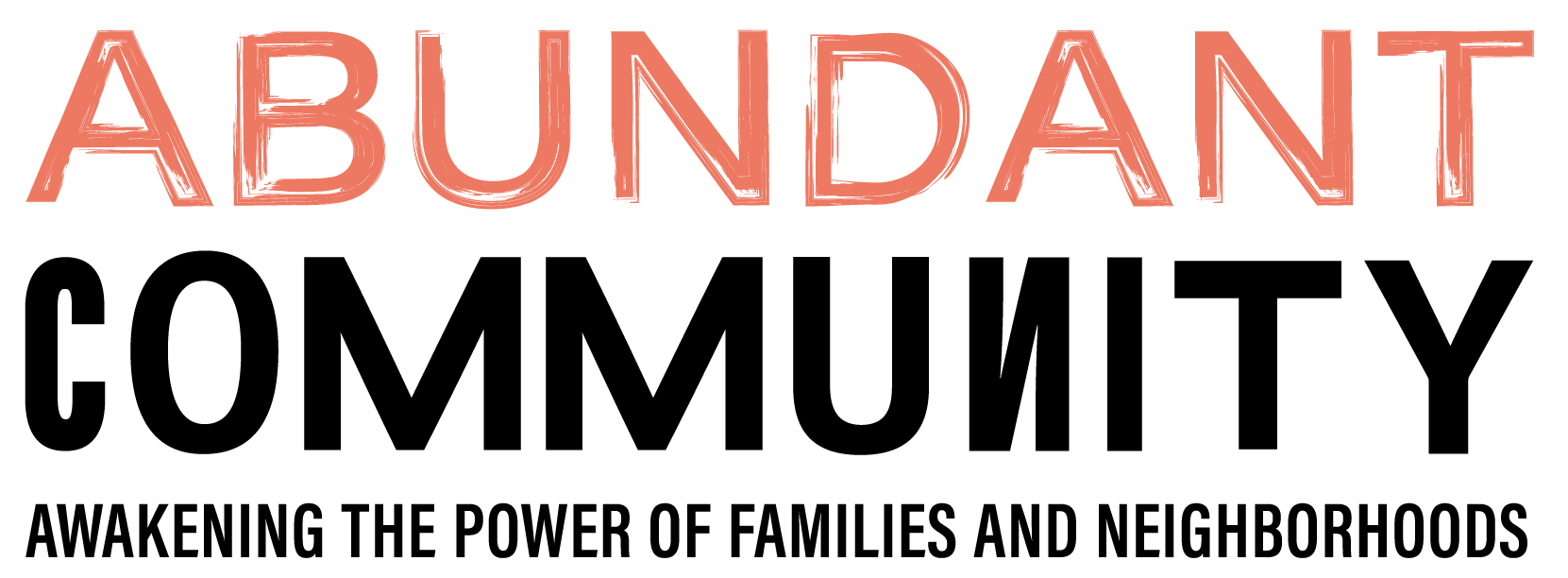From July 7 – 12, I had the opportunity to attend the Toronto Summer Institute on Inclusion, Diversity and Community for the first time. I can easily say that it was life-changing experience.
The Institute is a gathering of people who care about inclusion — that is, creating a world where all people are valued and welcomed for their gifts. Created 26 years ago, TSI has historically focused on the issue of disabilities, but those who attend are also engaged in creating inclusion of all kinds of people who are often marginalized and left out of community life because of labels which emphasize their deficiencies rather than their gifts and abilities.
I’d been wanting to come for years, ever since I heard of it through colleagues in the asset-based field. Now back home from Toronto, I am still buzzing with the insights, learning, relationships that I found there. While it’s impossible to cover them all, I’ve made an effort to pull out some highlights. In this article are the first two.
1. The People and a Structure of Trust and Freedom
Perhaps the greatest highlight of TSI was the people. I was surrounded by passionate, deep-thinking people who are taking action in their own communities and beyond to turn ideals into reality. I made incredible connections, and the 6-day length of the conference made it possible to “go deep” and spend the time that’s needed to form bonds with other people. I met accomplished older people willing to both share their learning with me and to listen to my perspective, and I met peers my age in a similar position of uncertainty and yearning to grow in our professional lives. I came away feeling 20 times richer from these new relationships and the countless illuminating conversations I had with the people I met there.
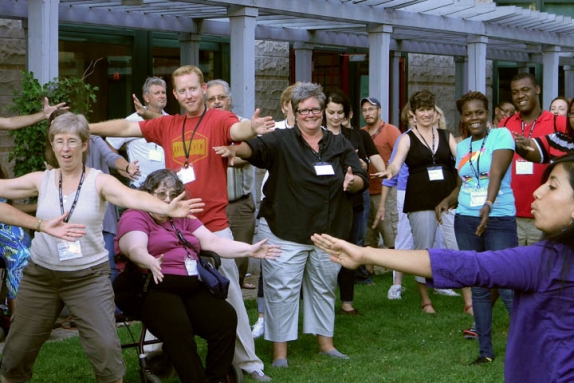
I was also impressed by the way in which the format of the conference mirrored asset-based principles. Rather than prioritizing a “top-down” format wherein the organizers or visiting “experts” grant wisdom and knowledge upon the participants, the people coordinating the Summer Institute designed this to be a platform where participants’ existing assets could emerge, interact, impact one another, and together create something more than the sum of our parts.
One of the most magical parts of the conference was when the huge white paper labeled with days, times and locations was filled with sessions that we were called upon to propose. By invitation of Jack Pearpoint, we all took some time beforehand to reflect on what we’d most like to share, discuss or explore with other people. We then lined up to explain our idea and invite others to join us.
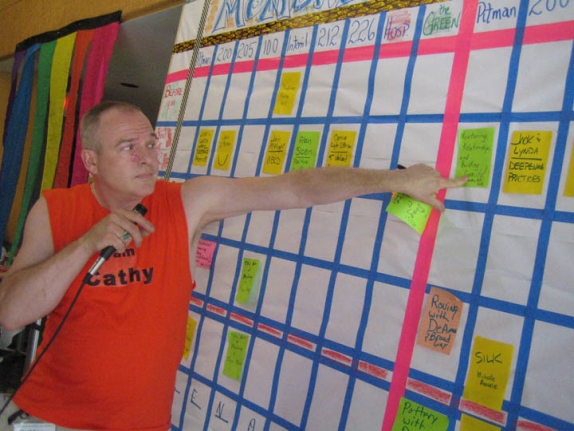
I noticed a unique kind of energy began to swirl both within and around me as we reflected, then stood up, and heard one another’s’ passions emerge. The themes were surprising and intriguing, and the greatest pain of my six days there turned out to be the sadness of not being able to clone myself and attend them all. Participant-led sessions included “Zumba,” “Improv and Inclusion,” “Cultivating a Culture of Gentleness,” “Faith and Inclusion” and “Scarf-making” with a professional artist.
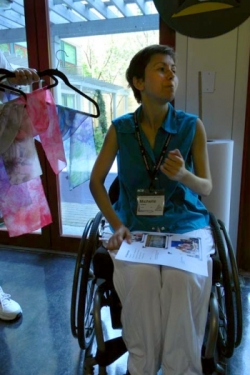
To me, this experience in itself was instructive as to how those of us who care about building community can best do so by creating spaces that invite others to articulate their interests, take responsibility for joining with others to explore that interest or work toward a shared dream, and pool the resources, talents and abilities they have already.
2. Discovering “Positive Uncertainty”
I came to this conference at a point in my life where the possibilities are as numerous as the doubts, confusions, and obstacles. I know that my prime passion is building community and have initiated a project with a former co-worker to find a way to do this work professionally. I also just took on a six-month job applying ABCD principles in a nearby town.
Despite the many workshops I’ve attended and hours of on-the-ground practice of asset-based work, I still find myself plagued with a feeling of uncertainty and, just as bad, a sense of alone-ness in my work. I often try to combat these feelings by tightening the grip, thinking, “If I can only focus more, be more productive, and come up with the perfect strategy, things will fall into place.” It was this inner struggle that led me to join the three-day morning module led by Alan Sloan titled “Positive Uncertainty: Working with Change and Challenges.” I can easily say that the perspectives he shared in the three sessions were exactly what I most needed to hear at this point in my life.
The workshop intro read: “The future is always uncertain, but that uncertainty does not have to be a cause of fear and worry. We can always find the resources within ourselves and within the situations we are facing to be flexible, courageous and creative.”
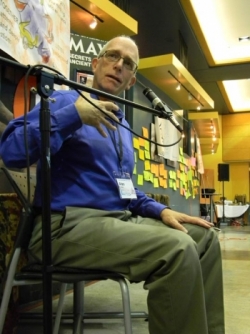
Alan led us through 15 minutes of mindfulness at the beginning of each session. We learned to be relaxed, vulnerable while at the same time strong and grounded while letting go of the constant scramble of our “thinking” mind. In short, we practiced being present. I realized that a large part of my suffering comes from leaving the present and getting way too caught up in my “thinking” head.
I was also fascinated by Alan’s description of love and power, based on Adam Kahane’s book Power and Love. Love is a way of being open, inclusive, understanding, warm, and embracing. Power is a way of being direct, decisive, moving into action, calculating, and sometimes sharp. These are two abilities that we need, but we also need intelligence/wisdom to utilize appropriately. Often, as individuals and as groups or organizations, we achieve less than our potential by staying in just one of these two ways of being.
Most of us have been part of a group in which such an inclusive forum is created for everyone’s opinions that nothing gets decided. These groups often don’t last too long before most members drop out. This is an example of “Love” being prominent — but on its own, without “Power,” it lacks effectiveness.
On the other hand, when we work with only “Power,” we run the risk of excluding people and their valuable perspectives, or breeding hostility and resistance, and taking action that is equally as ineffective. How many times have we heard citizen complaints of a local government that came up with a community development plan without involving enough people from the actual community?
We also act with Power ineffectively as individuals. For instance, how often do we try to get someone to take on our viewpoint, or change something about themselves? How often does it work? Our viewpoint, action plan, or critique of them might be spot-on, but if it’s lacking a willingness to include them, what they think, or who they are right now, 99.999% of the time, our efforts will only incite, at best, hostile complacency and, at worst, resistance and rebellion.
How do we use these two forces well?
At one point, Alan drew a picture of a human body. One leg was labeled “Love” the other “Power.” On the torso he wrote “Intelligence.” The key, he said, is to cultivate a mind that can be present in the circumstance and capable of perceiving which “Leg” to use, and when. In a word, it comes down to being present.
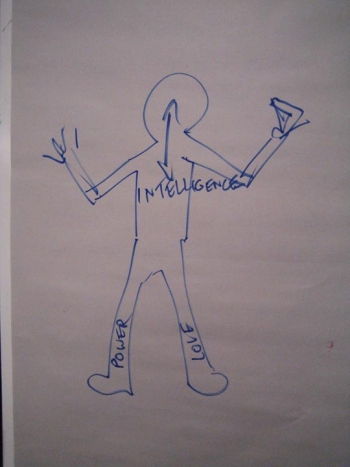
One neat framework for practicing this necessary presence is Theory U, a framework developed by Otto Scharmer and the Presencing Institute. Basically, this approach is not something “invented” but rather a way of describing what people and groups do when we truly engage in a creative way with a challenge or a project. It outlines a process “letting go” and “letting come.” “Letting go” involves working through layers of judgment and cynicism while activating our inherent powers of opening the mind, heart and will to the possibility that wants to emerge. “Letting come” involves a crystallization of vision and intention, prototyping and experimenting, and “performing by operating with the whole.” Below is a diagram of the “U.”
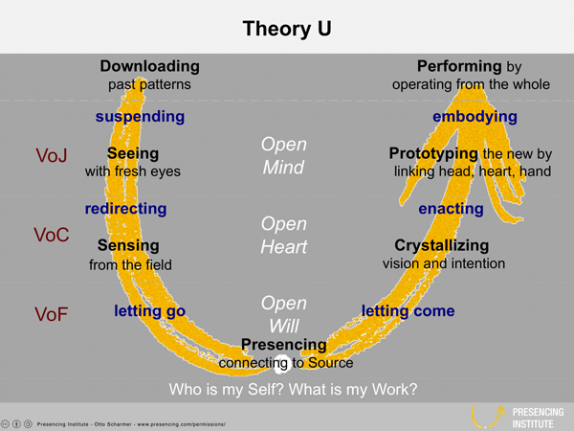
During a break-out discussion, Teaching Assistant Peter Gilli posed the question of whether any of us had experienced this process before, on our own. At the time I didn’t have a good answer, but a day later it hit me that I experience this whenever I sit down to create an original p-iece of artwork in pen.
Unlike many other projects I take on, when I draw this way, I operate from a pure place of openness, inventiveness and creativity. I draw something freestyle without really thinking about what the whole picture will be. The first thing I draw — usually an eye — leads to the next few lines. Pretty soon, I have a good sense of what is coming out but continue discovering and playing with the reality I’m birthing with ink onto paper. Often I’ll jump around different parts of the image — as one piece is drawn, such as a tree or mountain or the darkening of one line, I see how another piece can be refined to look better in relation to this new development. During this process, I’m not “thinking” in the way I usually do as I plan a project, which often happens with a sense of urgency to know the right strategy or discomfort with the uncertainty of whether I’m “getting it right.” Instead, I’m open, curious, inventive and at the end, I’m always satisfied. Sometimes that work of art even spurs another down the road.
I walked out of that workshop a comforting realization that it’s OK to be confused. I still get a flutter of anxiety in my belly when I think of those aspects of my projects that intimidate me, but there’s another understanding that, basically, this feeling is OK to have and there IS a way to move through it into a truly creative and deeply-informed “birth process.”
~ ~ ~
Perhaps the neatest realization I now hold is that, whatever comes out of these things I take on, the result will be greater than what my current brain can imagine. I look forward to reading more into Theory U and putting into it practice … to “let go,” “let come” and see what emerges. Plus, I come away from the Institute with friends who are also pushing themselves to discover their “learning edge” — as with all things, this process of personal learning and trying to make good change in community is better when done in company than when done alone.
I’m so grateful to the organizers of the Institute for this amazing experience — for these insights and new friendships. Stay tuned for my next installment of “Highlights from TSI” with stories from a “Roving Listening Workshop” and insights into the power of curiosity and questions.
~ ~ ~
The Toronto Summer Institute on Inclusion, Diversity and Community is hosted through Inclusion Press and The Marsha Forest Centre: Inclusion, Family, Community. Principal organizers are Jack Pearpoint, Lynda Kahn, Cathy Hollands and John O’Brien.
For further exploration:
- Inclusion Press www.inclusion.com
- The Presencing Institute http://www.presencing.com
- Alan Sloan alansloanconsulting.ca
